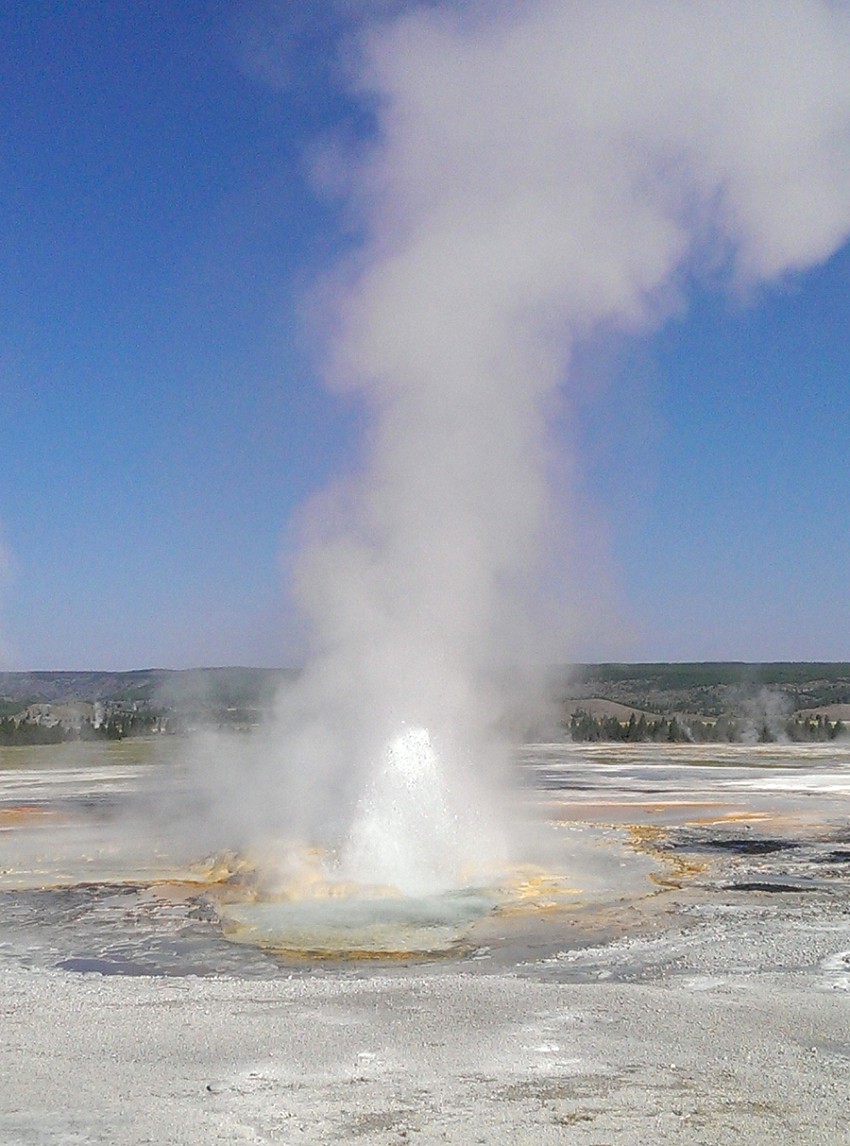Yellowstone is huge, large enough that if you have kids in the back seat, you might get an “Are we there yet?” between points of interest. It took us about 45 minutes to reach the Lamar Valley from the north entrance. The opportunity of an animal encounter can happen anywhere in the park, but we had read that our best chance of seeing those types of animals was there. It didn’t take us long to realize we weren’t going to.
And while that might be close enough for Bette Midler, we didn’t have time for that. Nor really the desire. We wanted a squeal-our-tires, fumble-with-our-camera, hope-our-car-rental-insurance-covers-claw-marks animal encounter. It was a bummer, but only slightly so, as the real reason to visit Yellowstone is to witness the strangest and most amazing geographical features on the continent.
But just as we’d declared those grapes sour, we were buffaloed by a buffalo.
Now, buffalo was low on my list. I’ve seen them up close on drive-through animal safaris a couple of times. Heck, there were herds of them in paddocks on the route to Yellowstone. Still, I can’t ever be disappointed at being three feet from one of these bizarre monsters in the wild.
They’re so…alien. I mean, we usually reserve that term for the deep-water aquatic species, but buffalo deserve the descriptor too. I mean, these massive brutes have these shapeless shaggy heads that look like they’ve been grafted on by Dr. Moreau. Mostly, though, it’s those eyes. Their cranium is so large and the hair so bushy that their eyes appear to be on opposite sides of their heads, like a lizard or a fish or Benedict Cumberbatch.
And, honestly, those weird cow-lion-fish fit right in the alien landscape that is Yellowstone National Park.
I mean, sure there are green forests and rolling hills and majestic mountains and picturesque streams in Yellowstone, but its signature features are all…otherwordly. And scalding.
See, Yellowstone sits atop a volcano. Actually, a supervolcano. Actually, the largest active supervolcano on the continent. That’s right. Active. This thing is the eventual bringer of our destruction.
The map we were handed at the guard station superimposed the borders of its caldera over the park. It covered almost the entire thing, like those pictures you see of Alaska overlaid on the lower 48 states. The funny thing is—and that’s “Ha. Ha. We’re all going to die” funny—scientists have recently reevaluated the size of the volcano, now claiming it’s twice the size of their previous estimate. Basically, they went from “North America is eventually screwed” to “North America is eventually really screwed.”
In fact, while we were there a loop of road had been closed off because the asphalt itself had melted into a morass. I mean, that’s a terrifying taste of what’ll happen to our infrastructure when that guy below stops being the Clark Kent that is a national park.
The first site was saw was called Artists Paint Pots on the map. We parked in the lot and took a path through a forest. As we got closer to the mudpots, everything turned foggy and spooky and weird. I mean, I’ve been to Centralia, and that was an airy Kansas plain compared to thick atmosphere of this place. And this wasn’t a cool fog, either, it was a heavy, sulfurous miasma. The smell wasn’t too bad, less like rotten eggs and more like, I don’t know, steamed eggs. And that steam was so thick that it condensed onto the many spider webs that festooned the place, creating these brightly reflecting patterns that contributed to the eeriness. Eventually the path became a boardwalk and we were at the Paint Pots themselves.
The cause of all this strangeness was microorganisms that consume the hydrogen sulfide that seeps from You-Know-What below the park, converting it to sulfuric acid, which breaks down the surrounding rock into gloopy clay. Regardless of the scientific explanation, the effect is like walking on another planet.

I don’t know if this is coming across in this post because of all of my apocalyptic terminology, but we were having a blast at the park. Unfortunately, we had only two more stops before our too-brief Yellowstone jaunt was over: Grand Prismatic Spring and Old Faithful itself.
 |
| This sign was everywhere. I love it. They need to sell it in the gift shops. |













